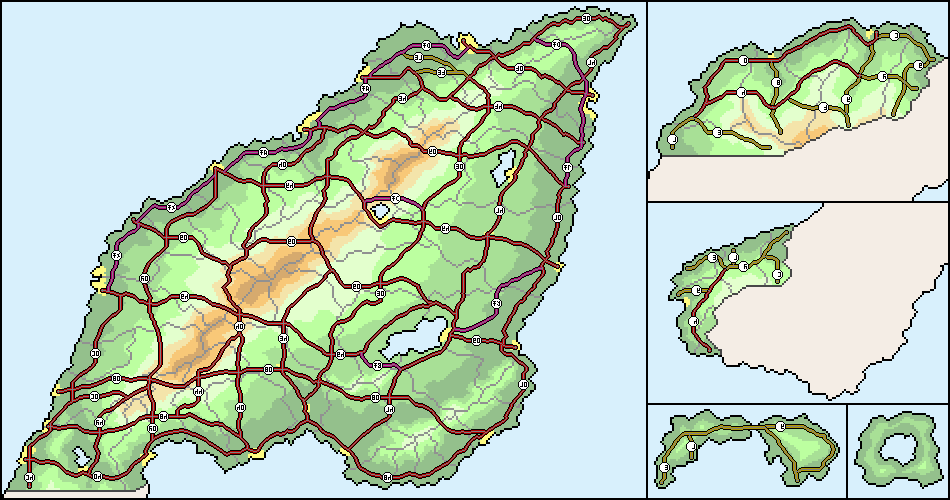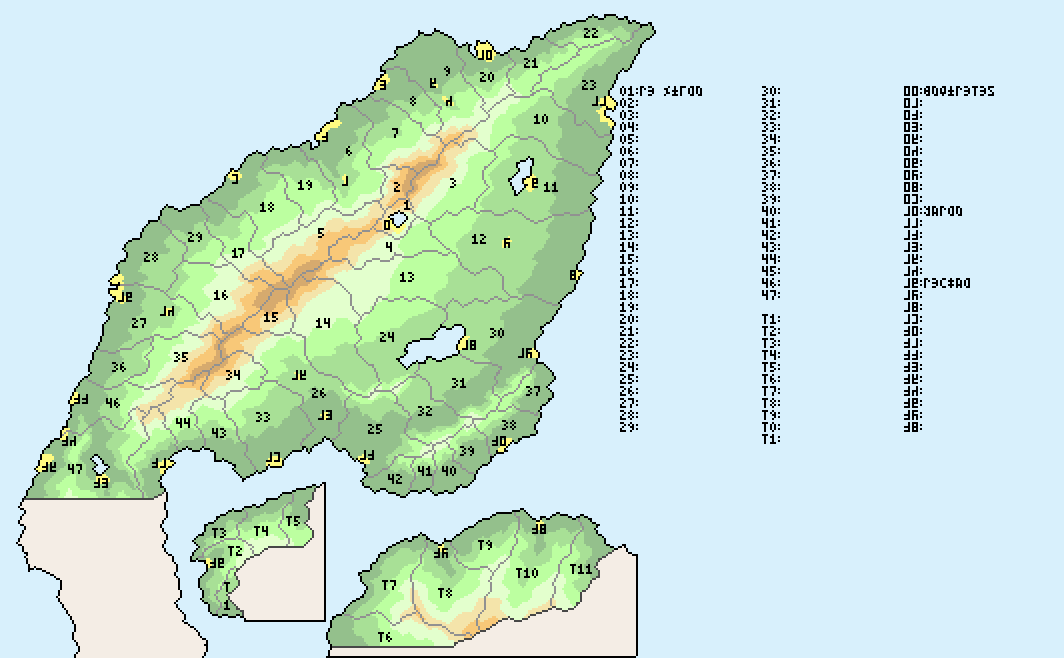
Astarey is a large independent state whose provenance is rather twisty. Today, it functions as somewhere between a parliamentary democracy and an elected monarchy- with all of the neoliberal conservativism that implies.
The Astarese parliament is unicameral- with some oddities. There are five sets of parliamentarians, elected or appointed in different years- the first, consisting of local representatives, is elected in the same cycle as the sovereign; the second, consisting of clergy and hereditary parliament positions is appointed/confirmed by the sovereign two years in; the third, also consisting of representatives, replaces the first set by election four years in at the sovereign's mid-term; the fourth, consisting of further noble parliamentary positions, is elected six years in; and the fifth, consisting of higher-level local representatives, is elected at the same time as the fourth. The cycle begins again two years later. Theoretically, this means that a sovereign's term can be partially kept in check by the representatives, clergy-parliamentarians, and hereditary/noble parliamentarians of the previous sovereign's term.
From the centre of the image outwards, the assemblies are:
- The Spiritual Parliamentarians, mostly members of the National Church (with the Speaker at the centre) [68+1 members]
- The Hereditary Ministers, split near-equally between various noble branches [96 members]
- The Elected Ministers, split between parties (though four members of it are actually leaders of noble branches) [284 members]
- The National Council, as well split between parties [132 members]
- The Delegates Of The Nations, split between parties- especially smaller ones (plus two seats for the prime ministers of the Government and Opposition) [462 members]
This brings the total size of the parliament to 1043 members, including the Speaker.

The Conservative party has the largest share of seats in the Astareyn(?) parliament (a share of 98/51/136 between the elected ministers, the councillors, and the delegates), and is a fairly textbook "centre-right patriot" party. Their party color is orange.
The National Prosperity party is often considered subordinate to the Conservative party (52/16/22), but often prevails (and is most different from the Conservatives) in regions where the party being explicitly pro-agrarian matters. Their party color is lime.
The Democratic-Liberal party has successfully merged two "centre-left" parties to gain a greater share of seats (60/31/32), though their votes have been running away in both directions recently. Their party color is sky blue.
The Social Progress party fills the niche of "ineffectual leftist party", and its controversial policies have caused it to be unpopular (12/6/30). Their party color is red.
The Green party... well, shouldn't it be obvious? In recent years, with smog making a comeback over Astareyn cities, the Greens have become popular enough to challenge other second-tier parties (10/6/36). Guess their party color.
The Balance party is certain it is centrist, and so is its dedicated cadre of voters (26/9/62). The party is remarkably harmonious despite its two wings- centre and far-right. Their party color is purple.
The Covenant party- not to be confused with the church that it represents, or the Astareyn Covenant that it split from- is a remarkably large (12/5/30) party that exists in lieu of representation in the Spiritual section of Parliament. Their party color is blue.
The Progressive Conservative party largely serves as a vehicle for radical "technocrat" Marna Salias, and is popular in suburban technology hubs (1/26). Their party color is gold.
The Apira Autonomy party does what it says on the tin, and is popular where expected (12/6/36)- in the wide peninsula on the side of Astarey. Their party color is dark red.
The Nation for Eldega Serra is another vehicle for one person. Their goals revove around "choice in medicine", half in a "no more healthcare" way and half in a "no vaccines" way, a worryingly popular combination (1/32). Their party color is blue-green.
The Team of Calay Bedic focuses on "total economic independence" in an ill-defined enough way that it is marginally popular (10). Their party color is salmon.
The New Political Network offers a "new system" indistinguishable from near-conventional far-right policies. They're the smallest party with seats (8), and their party color is fuchsia.
Astarey's largest structure is the Spacecraft Assembly and Integration Building, built for simultaneous moon missions and later expanded to accomodate vast nuclear spacecraft that were never built. It is so vast that even with the frantic production required to supply Astarey's paranoia- silos, on-orbit interceptors, orbital and flyby manned and unmanned spy craft- much of its upper area is unused. The SAIB's ridiculous height means that at 298 metres it is still in the top 50 tallest buildings in Astarey, and its multiple construction bays mean that it has a total volume of 13 million cubic metres.
The tallest building in Astarey is Federal Tower, and its height of 10 furlongs- while exceeding the summit of the mountain it is built on the side of- requires guying and staying wires and cables so numerous that no construction is allowed within a radius double its height- 4018 metres.
In Astarey, the oldest building is the 1300-year-old Cathedral-Archbasilica in the old capital Reczad, a work of a pagan empire taken over by the church. It is studded with statues and images of pagan goddesses recontextualized as saints.
Astarey's space agency, on account of its oversized budget, has had the opportunity to pace its space programs to enhance safety (and the number of military applications that can be fit into each program). This means that-with the addition of the lackluster state of computing in Astarey- manned missions have become almost routine for the past sixty years, using very similar spacecraft. As a result, Astarey operates a remarkable amount of orbital stations (both overt "civilian", known "military", and covert "military") around Utopia, Silona, and even a couple orbiting Bahram (do not refer to Bahram as Bahram within earshot of Astarese officials).
This is not to discount unmanned spacecraft- though these make up slightly more than a third of all launches, they remain relatively important in Astarey's space operations. Most unmanned launches are of Utopia-orbital craft, especially communications spacecraft, but several landmark unmanned missions have been completed- landers for Naheed and Bahram, multi-planet flyby missions, and even an Aurora (do NOT refer to Aurora as Aurora within earshot of Astarese officials) atmospheric entry mission. Most recently, full "practice" unmanned missions to land on Bahram and flyby Aurora have been completed, and their manned counterparts are to follow soon.
Astarey has an extensive unmanned civilian space program, though not as extensive as that of a more modern nation. Operations have taken place near every planet in the Łetaraig system, and several decades-old missions remain operational.
Three spacecraft- each having visited one of the three gas giants in the Łetaraig system as primary target, and each about three decades old- are on varied trajectories far from Łetarai. Two- the Berjis and Kayvon flyby ships- are on slow escape trajectories, while the dedicated Aurora flyby mission is fulfilling its secondary role as a mission to study the poles of Łetarai.
Aurora is host to a spacecraft designed to orbit it and repeatedly flyby its several planetary moons, operating there for just over a decade. The minor planets between Utopia and Aurora have been visited both by flyby ships, orbiters, and even two landers (one accidental).
Of Astarey's seven deep space observatories of various sizes and wavelengths, three orbit at Utopia's L2 point and four orbit Utopia itself. There are several other Łetarai-orbiting spacecraft, including three spacecraft specifically intended as Łetarai observatories. Utopia is likewise host to two dozen operational observatories, weather satellites, and similar craft.
There have been dozens of spacecraft sent to Naheed and Bahram, though the manned Bahram program has mostly taken control of Bahram-local operations. At the moment, one rover-lander-orbiter combination is operational at Bahram, along with several orbiters currently operating as relay satellites. Naheed currently is host to three orbiters and one long-duration balloon flier, and one Chor repeat-flyby ship is finally easing into its final orbit.
there are a dozen plus one civilian space stations, most of them are monolithic
the two that orbit chasz are together permanently manned, every third crew rotation makes sure the secondary station is ready in case something fails on the primary and the crew tug has to dock the two together/leave. they've each got a six-direction hub at the end- two (port and starboard) of its docks are active and occupied by lunar landers (one taxi, one cargo), the rear one was passive but has an androgynous attached now, and the zenith and nadir ports are passives (or androgynous?) open for cargo ships, tankers, rescue ships etc; there's a forward androgynous port for attaching to the other station or a second crew ship or even making a multi-module station
there are a buncha small jobs in LUO- wet and dry workshops, inflateables, a little centrifuge all of which at least have their orbits maintained, which accounts for another seven
There's a modular station in orbit whose job is to prepare stuff that's going to Chasz and another for stuff going to the inner planets, both of those are up in high orbit though the second is a good deal higher
And then there's the BIG modular one, studded with various kinds of docking ports that are obsolete and capable of supporting activities from science to preparing spacecraft to more science
The station around Bahram is pretty much a wet workshop mated to a Chasz-orbital station, the trick will be refitting the wet workshop for readiness while the forward station is full of supplies and machinery and extra life support stuff so the crew of the Bahram Orbital Spacecraft will have to stay in their own ship for a while (though the prototype unmanned ship from the unmanned landing is also available cuz it'll depart for home with the ground samples at the same time the manned ship will depart for home)
Then there's the big crewed civilian ships- the flyby ship that helped oversee the sticking into orbit of the Bahram station is almost home, the flyby ship that helped oversee the operations of the unmanned practice run for the manned mission to the surface is just about at Naheed deploying its payloads for there, and of course the Bahram orbital spacecraft ejected just recently at about the same time Ausvalia's probe did
Astarey also has a ton of optionally-manned civilian craft- the geosynchronous relays, the Chasz relay, again the practice run ships, the supply ships for all of the space stations, the emergency return spacecraft also attached to the stations, and a couple Chasz supply landers are on the ground both near and away from the ground base in case something goes horribly wrong on the stations (the base also has its own bug-out go-home-immediately direct-return ship)
And of course there's, yknow, the actual civilian main space vehicles- mostly used as crew ferries or emergency craft now, their greatest achievement is flying to Chasz alone. There are a few types in use, all stemming from an original two-person craft used for orbital maneuver work- though pretty much only in name, as practically every part of the ship has been redesigned or discarded to accomodate the current five-person design- a wide capsule tolerable for a few days at a time, with varying arrangements of mission module (from small satellite to full-on habitation module) and service module (from LUO ferry to Chasz round-trip to heavy orbital tug). This basic design persists for most of the main reentry-capable craft.
Nearly all of the others are based off of the emergency crew return spaceplane, with variants capable of light satellite deployment, spacecraft maintenance, and landing site verification. There are also several supply spacecraft with reentry-capable modules in the event of a catastrophe. In craft not capable of reentry, there are small crew ferries for maintaining satellites, Chasz (and, depending on definition, Bahram) landers, and tiny half-spacesuit half-spaceship vehicles for emergencies and maintenance.
Astarey was formed by a set of reorganizations of local government after a rebellion that broke the former state of Astarey- though officially these polities are contiguous, and in fact officially Astarey is supposed to have evolved from colony to empire to kingdom and beyond rather than having broken up and not been recognized as successor several times in its history.
Astarey has a preoccupation with the osprey- not only an ancient imperial bird, but a useul representation of the seagoing journey that founded Astarey. The osprey was once seen as a second-tier bird of prey, as the junior to the more proper Sēlladus Imperial Falcon. As such- with Astarey's homegrown empire gradually coming to terms with the fact that it was irrevocably severed from Sēlladus- the osprey was adopted as a reference to the ancient ties without engaging in the single-empire delusion.
Astarey has multiple computer communications networks that could charitably be described as an "internet", although none have anywhere near the membership or capability of similar networks in other nations.
The largest, oldest, and most restricted network is the National Defense Connector, a behemoth establshed five decades ago as a way to communicate between the twenty National Defense Supercomputers then in service. Starting twenty-five years ago, the National Defense Connector was redesigned from the ground up as a distributed computing and communications network- military leadership suddenly realized that the proliferation of pure-research and solely-commercial computer networks could represent a hole in the NDC's security. At the moment, the NDC contains an estimated three thousand nodes and operates at an optimum estimated speed of six megabits per second.
There are two research networks in Astarey- the Intranational Scientific Relay and the Astarese Supercomputer Network. The Intranational Scientific Relay mostly connects universities, and is the second-largest network- its bloated size means researchers often use it to send "virtual letters" between its two thousand nodes. They load easily at a cool speed of 200 kilobits per second. The Astarese Supercomputer Network is a good deal smaller than the ISR, and is disused- Astarese supercomputers mostly communicate over other networks, when they're designed for communications at all.
There are several commercial and personal networks- commercial networks tie together most companies that span the nation, and interpersonal networks are available if one has the huge sums of money required to purchase a computer capable of connecting to one. Several library networks have banded together to create their own "personal" network, although few library systems have more than one node in such a system.
Just a few years ago, the five nationwide computer access companies (and several regional ones) decided to pool their resources to create one single "intergalactic network"! Messages can now be sent across individual companies' networks, or between them! Prices and message retrieval times may be slightly higher due to the difficulties of this integration. With the intergalactic network comes the "computer phonebook", a repository of information about computer locations in cities across Astarey and who can be contacted most often there. Information is also included on interesting businesses in each city, to improve vacationing!
National Security Highway 80, in southern Astarey, has an extremely long straight stretch barely a hundred kilometres long starting just east of the junction with NSH 35 and ending just east of the junction with NSH 50. Its speed limit is the highest in the country, starting ten kilometres in at 140 km/h. The rail beneath NSH 80 is straight for considerably longer, given its job is to directly connect the cities at the westmost point and midpoint of NSH 80, and the high-speed National Security Experimental Rail Vehicle Project production model trains that travel along it can traverse its four hundred fifty kilometre stretch in an hour and twenty minutes.
Rumors abound of a secret direct railway along about thirteen hundred kilometres of Astarey with stops in just three cities, but this is considered unlikely due to the fact that such a rail tunnel would have to bore through much of Astarey's central mountain range. Nevertheless, theorists say that this railway hosts a unique airtight vacuum train that travels the full length in just an hour.
Urban areas in Astarey and their suburbs are considerably more disconnected than many would expect. While about half of the working population in each city lives within the urban area of the city, the rest come from outside- and in most cities this means that half of the workers travel by train, light rail, or bus; and the other half travel by personal car. It is generally expected to own a car in Astarey, if not to go to work then to travel to the disparate locations a good citizen would go to. Government workers overwhelmingly travel by rail, mostly because rail systems are often established to provide a direct connection to government buildings.
astarey has three contenders for the title- two supersonic bombers and one extreme-velocity intercontinental cruise missile. the extreme-altitude bombers were proposed a few years apart from each other- the first before astarey developed high-altitude surface-to-air missiles, the second almost immediately after. both were developed even as both their roles began to seem outdated, and today the high-altitude bomber most often serves theoretical early warning and command purposes, while the lower-altitude one is very good at air shows. the cruise missile remains deployed in silos to this day.
Astarey is a USA/UK ripoff whose saving graces are that its technology is too shitty to be totalitarian and it doesn't have the ability to be an imperial core because it has very little international power. It exists cuz I thought making a national highway system would be cool.
Astarese numerals and script (not in actual order). 0 1 2 3 4 5 6 7 8 9, a b c d e f g h i j, k l m n o p r s t u, z (ch sz th). Digraphs are cz and gk. Phoneme /w/ does not recieve an individual letter- it's lumped in with u.

Astarese highways maintained to National Security Highway standards. NSH-00 through 99, plus ancient "Wia" roads.

Named Astarese *states and cities.

There are three extremely prestigious board games in Astarey with a close tie to the history of Astarey's governments- respectively the Emperor's Game, the Regent's Game, and the Sovereign's Game. Each is closely related to the others, and in fact all three certainly stem from a common ancestor that has been lost to the transition from Selladus to Astarey thousands of years ago. The naming scheme, however, is much more recent- when the Sovereign's Game came into its current form and was adopted as a pastime by the nobles of early modern Astarey (soon after the instatement of a Sovereign-and-Parliament system for the governance of Astarey), the Regent's Game and the Emperor's Game switched places as an attempt to deprive the former Regency-based government of Astarey of some of its legitimacy and to tie the current Sovereign's rule to that of the ancient Emperors.
The Regent's Game is widely accepted as the most basal and simplistic form of the game, likely the most closely related to the ancient original game but historically considered a version of the other two suitable only for commoners. The most popular form is played on a 9x9 board by two players, each of whom has up to 18 pieces that can be placed on an unthreatened square at any point in the game. These pieces are helpless on their own, but can move together in formations. Formations have movesets and attacks divergent from those of the one-square-in-any-direction singular pieces, and are the main unit of battle on the gameboard. The most common formations are four-piece lines and four-piece squares, able to attack more swiftly and less vulnerable to attack respectively, but others are more common- especially in other forms of the game.
The Emperor's Game is generally considered to have arisen relatively soon after the transition to Astarey, and is generally more popular but less prestigious than the Sovereign's Game. Like the Regent's Game, it too is often played on a 9x9 board by two players (though 13x13 variants with four players are also common and occasionaly touted as the 'original version'). The Emperor's Game has two major differences from the Regent's Game: first, the board is bisected by a "river" which formations cannot cross alone (in four-player versions there are instead four rivers with an impassible "mountain" tile at the centre)... and second, each formation is a single piece. More formations are usually in play in the Emperor's Game, with more movement patterns, but to cross the rivers a special 19th piece is required- the Commander, which can only assist one formation at a time.
The Sovereign's Game is the most recent form of the game, and is sometimes said to rely on complexity for prestige. Unlike the Emperor's Game's vague replication of the Four Rivers Of Old Selladus, the Sovereign's Game is played with a set of several standard "terrain" boards that much more closely conform to regions of Astarey. Formations and Commanders are similar to those in the Emperor's Game (though there are more available to players than in either the 9x9 or 13x13 forms of the Emperor's Game), but worse the Sovereign's Game is played on a much larger 17x17 board. Unique to the Sovereign's Game are Mercenaries, a special formation that is capable of stronger attacks than any other formation but if encircled switches sides. Many variations of the Sovereign's Game exist, usually centering around ever-more-complex relationships between formations, commanders, and terrain.